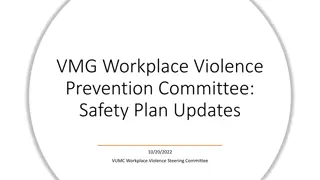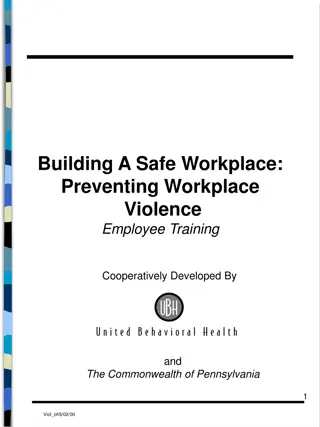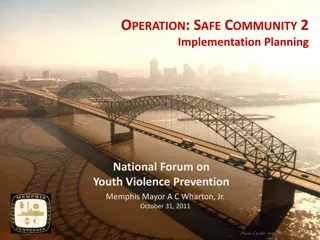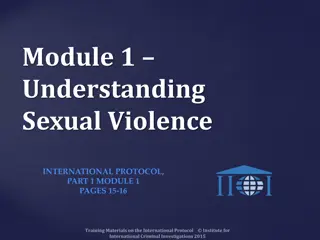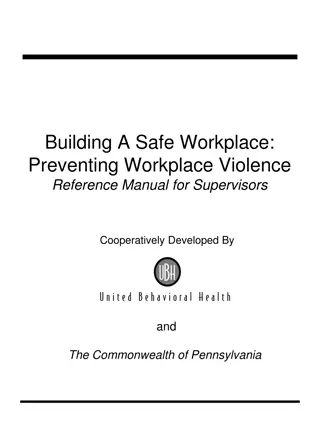Workplace Violence Awareness and Prevention Guidelines
This guide covers the risks and warning signs of workplace violence, including factors like contact with the public, employer-directed violence, and behaviors indicating potential threats. It emphasizes understanding policy requirements, recognizing violent behavior signals, and taking appropriate action to ensure a safe work environment.
Download Presentation

Please find below an Image/Link to download the presentation.
The content on the website is provided AS IS for your information and personal use only. It may not be sold, licensed, or shared on other websites without obtaining consent from the author. Download presentation by click this link. If you encounter any issues during the download, it is possible that the publisher has removed the file from their server.
E N D
Presentation Transcript
Contact with the public Delivery of passengers, goods, or services Having a mobile workplace such as a taxicab or police cruiser Working with unstable persons in health care, social services, or criminal justice settings Working alone or in small numbers Working late at night or during early morning hours Working in high-crime areas Guarding expensive goods
Employer Directed Violence against Authority Property Directed Acts against UNK Property Domestic Violent acts against a person of desired intimacy Commercial Theft of money or property
Loss of life Rape Assaults Loss of productivity Absenteeism Tardiness Sick time abuse Theft or property damage Employee turnover, lost training Employee anxiety and fear
Complains about even simple tasks Poor work reviews Absenteeism or tardiness Unable to accept direction or criticism Blames others for problems Difficulty working with others History of violence History of Drug and/or alcohol abuse Emotional problems or mood swings Obsessive talk or behavior towards co-worker
Slamming doors, swearing, outbursts of rage Sudden change in behavior Relationship changes Financial problems Portrays themselves as a victim Talks to themselves
Verbal abuse Indirect threats Direct threats Nonverbal threats Extreme threats Violent actions
Understand the scope of workplace violence Know the policy requirements Recognize warning signs of violent behavior Be prepared to take appropriate action
UNK Policy Violent or threatening behavior directed at staff, faculty, students, visitors, oneself or property will not be tolerated at the University of Nebraska Kearney. This policy applies to any acts of violence or threats made on property controlled by the University of Nebraska Kearney, in University vehicles, and at events sponsored by the University or under other circumstances that may negatively affect the University s ability to conduct business. Included in this prohibition are such acts or threats of violence whether made directly or indirectly, by words, gestures or symbols that infringe on the University s right or obligation to provide a safe workplace for its employees, students and visitors. UNK Workplace Violence Policy can be found at: http://www.unk.edu/bf/_files/PoliciesAndProcedures.pdf#nameddest= Workplace_Violence_Policy
Any member of the university community observing behavior that is in violation of the work place violence policy, or that could reasonably be interpreted as a precursor to an act of violence, or intimidation, shall make an immediate report to UNK Police and Parking Services. In case of imminent danger, UNK Police and Parking Services will intervene. When time and circumstances permit, the supervisor of the employee-victim and/or employee- perpetrator, the Director of Human Resources and the Director of Police and Parking Services will make a threat assessment and report to the Vice Chancellor of Business and Finance.
When confronted with an angry person: During an event, use the flowing steps as means to attempt to diffuse the situation. * Put departmental plan into action. * Try to stay calm. Raising your own voice may increase the anxiety of the potentially violent person. * Speak slowly, softly, and clearly to reduce the momentum of the situation. * Ask the belligerent person to leave and come back at a time when they feel more calm. * Move away from any objects, such as scissors or heavy objects, which may be employed as a weapon. * Avoid challenging body language such as placing your hands on your hips, moving toward the person, or staring directly at them. Remain seated and do not turn your back on the individual. * Position yourself, if possible, so that an exit route is readily accessible. * Listen empathetically by really paying attention to what the person is saying. Let the person know that you will help them within your ability to do so or you will send for additional help.
* Remain helpful while you summon your supervisor for assistance. Sometimes, the opportunity to talk to a supervisor will help satisfy an irritated client. * Neither agree with distorted statements nor attempt to argue - REMAIN CALM. Avoid defensive statements. This is not the time to place blame back on the enraged person. * Ask questions to help regain control of the conversation. * Ask uninvolved parties to leave the area if this can be done safely. Use the prearranged code word to alert your coworker to call University Police. * Never challenge, try to bargain, or make promises that you cannot keep. * Describe the consequences of any violent behavior. * Do not physically touch an outraged person, or try to force them to leave. * Calmly ask the person to place any objects that could be used as weapons in a neutral location while you continue to talk to them. * Never attempt to disarm or accept a weapon from the person in question. Weapon retrieval is only to be done by a University Police Officer. * Observe Who, What, Where, When for reporting purposes
Never confront an angry person directly Develop signs or codes in your office telling others to contact police Do evaluations or mediations with more than one person Set up your office to allow interference and escape recognize signs and acts
Report it to your supervisor Report it to next in command Report it to Human Resources Report it to Police Services Always Remember Document, Document, and Document!!!
Keep security doors closed and locked Do not share ID cards or security codes with others Follow rules for visitors Report unescorted strangers Report burned out or inadequate lighting
Report unusual or unexpected deliveries Report any type threats from people Report any signs of break-ins or missing items Take appropriate precautions when working late If you re being attacked, yell to alert others
UNKPD UNKPD Safe Walk Human Resources Dean For Students Conduct Officer Anonymous Reporting http://www.unk.edu/offices/police/police_services/unk_silent_witness.php 308-627-4811 (24hr cell) 308-865-8517 (office) 308-224-0853 or 308-236-2488 308-865-8655 308-865-8528 308-865-8519 Emergency Call 911
Buffalo Co. Sheriffs Dept. 308-236-8555 Kearney Police Dept. Crime Stoppers SAFE Center 308-237-2599 Buddy System/Kearney Cab 308-234-6725 308-237-2104 308-237-3424 Emergency Call 911








![Workplace Violence Prevention Plan in [District]: Definitions, Elements, and Implementation](/thumb/117038/workplace-violence-prevention-plan-in-district-definitions-elements-and-implementation.jpg)
